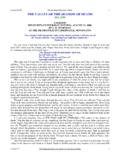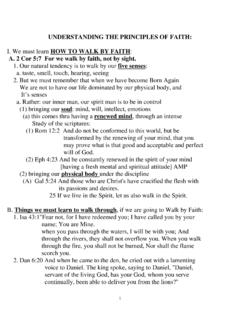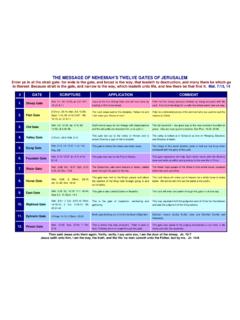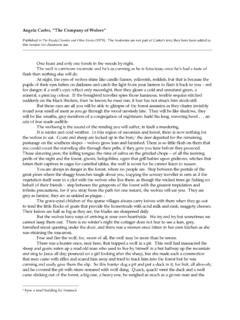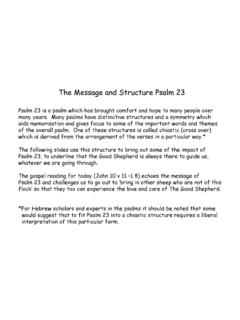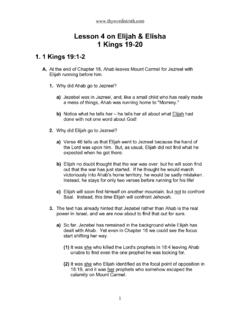Transcription of CREATION AND REDEMPTION - bulgarian-orthodox …
1 CREATION AND REDEMPTION . CREATION . AND. REDEMPTION . VOLUME THREE. in the Collected Works of GEORGES FLOROVSKY. Emeritus Professor of Eastern Church History Harvard University NORDLAND PUBLISHING COMPANY. BELMONT, MASSACHUSETTS 02178. MAJOR WORKS BY GEORGES FLOROVSKY. The Eastern Fathers of the Fourth Century (in Russian). The Byzantine Fathers from the Fifth to the Eighth Century (in Russian). The Ways of Russian Theology (in Russian). Bible, Church, Tradition: An Eastern Orthodox View (Vol. I in The Collected Works). Christianity and Culture (Vol. II in The Collected Works). Aspects of Church History (Vol. IV in The Collected Works). Library of Congress Catalog Card Number 74-22862. ISBN 0-913124-10-9. Copyright 1976 by NORDLAND PUBLISHING COMPANY. All Rights Reserved PRINTED IN THE UNITED STATES OF AMERICA. About the Author Born in Odessa in 1893, Father Georges Florovsky was Assistant Professor at the University of Odessa in. 1919. Having left Russia, Fr. Florovsky taught philosophy in Prague from 1922 until 1926.
2 He was then invited to the chair of Patrology at St. Sergius' Orthodox Theological Institute in Paris. In 1948 Fr. Florovsky came to the United States. He was Professor and Dean of St. Vladimir's Theological School until 1955, while also teaching as Adjunct Profes- sor at Columbia University and Union Theological Seminary. From 1956 until 1964 Fr. Florovsky held the chair of Eastern Church History at Harvard University. Since 1964. he has taught Slavic studies and history at Princeton Uni- versity. Fr. Georges Florovsky, Emeritus Professor of Eastern Church History at Harvard University and recipient of numerous honorary degrees, is a member of the American Academy of Arts and Sciences. About The Collected Works of Fr. Florovsky The Collected Works of Fr. Georges Florovsky will be published in English and will contain his articles in Slavic studies as well as in Church History and Theology which have previously appeared in Russian, German, French, Bulgarian, Czech, Serbian, Swedish and English.
3 Each volume will be arranged thematically. Included in the Collected Works will be his two major works on the Church Fathers (The Eastern Fathers of the Fourth Century and The Byzantine Fathers from the Fifth to the Eighth Century). and Ways of Russian Theology. The last volume of The Collected Works will contain an Index to the entire corpus. Table of Contents I INTRODUCTORY. The valley of the shadow of death 11. II METHODOLOGY. Revelation, Philosophy, and Theology 21. III CREATION . CREATION and Creaturehood 43. IV EVIL. The Darkness of Night 81. V REDEMPTION . REDEMPTION 95. VI DIMENSIONS OF REDEMPTION . Cur eus Homo? The Motive for the Incarnation 163. The Ever-Virgin Mother of God 171. The Sacrament of Pentecost 189. On the Veneration of Saints 201. Holy Ikons 209. The "Immortality" of the Soul 213. VII ESCHATOLOGY. The Last Things and The Last Events 243. NOTES. CREATION and Creaturehood 269. REDEMPTION 280. Cur eus Homo? The Motive of the Incarnation 310. The "Immortality" of the Soul 315.
4 The Last Things and The Last Events 317. I. INTRODUCTORY. The valley of the shadow of death "O Y E DRY BONES" .. Ezekiel 37. A GLORIOUS VISION was granted to the Prophet. By the hand of the Lord the prophet Ezekiel was taken to the valley of death , a valley of despair and desolation. There was nothing alive there. There was nothing but dry bones, and very dry they were indeed. This was all that had been left of those who were once living. Life was gone. And a question was put to the Prophet: "Can these dry bones live again? Can life come back once more?" The human answer to this question would have been obviously, no. Life never comes back. What is once dead, is dead for ever. Life cannot come out of dust and ashes. "Tor we must needs die, and are as water spilt on the ground, which cannot be gathered up again" (2 Sam. 14:14). death is an ultimate ending, a complete frustration of human hopes and prospects. death comes from sin, from the original Fall. It was not divinely instituted.
5 Human death did not belong to the Divine order of CREATION . It was not normal or natural for man to die. It was an аЬдогта1 estrangement from God, who is man's Maker and Master even physical death ; the separation "The valley of the shadow of death ," originally a sermon, appeared as an editorial under the title "O Ye Dry Bones" in St Vladimirs Seminary Quarterly, Vol. I, No. 3-4 (1953), 4-8. Reprinted by permission. 11. 12 CREATION and REDEMPTION of soul and body. Man's mortality is the stigma or "the wages" of sin (Rom. 6:23). Many Christians today have lost this Biblical conception of death and mortality and regard death rather as a release, a release of an immortal soul out of the bondage of the body. As widely spread as this conception of death may actually be, it is. utterly alien to the Scriptures. In fact, it is a Greek, a gentile conception. death is not a release, it is a catastrophe. " death is a mystery indeed: for the soul is by violence severed from the body, is separated from the natural connection and composition, by the Divine will.
6 О marvel. Why have we been given over unto corruption, and why have we been wedded unto death ?" (St. John of Damascus in the "Burial office"). A dead man is no man any more. For man is not a bodiless spirit. Body and soul belong to- gether, and their separation is a decomposition of the human being. A discarnate soul is but a ghost. A soulless body is but a corpse. "For in death there is no remembrance of Thee, in the grave who shall give Thee thanks" (Ps. 6:5). Or again: "Wilt Thou shew wonders to the dead? shall the dead arise and praise Thee? shall Thy loving-kindness be declared in the grave ? or Thy faithfulness in destruction ? shall Thy wonders be known in the dark ? and Thy righteous- ness in the land of forgetfulness" (Ps. 88:10-12). And the Psalmist was perfectly sure: "and they are cut off from Thy hand" (v. 5). death is hopeless. And thus the only reason- able answer could be given, from the human point of view, to the quest about the dry bones: No, the dry bones will never live again.
7 But the Divine reply was very different from that. And it was not just an answer in words, but a mighty deed of God. And even the Word of God is creative: "for He spake, and it was done; He commanded, and it stood fast" (Ps. 33:9). And now God speaks again and acts. He sends His Spirit and renews the face of the earth (Ps. 104:30). The Spirit of God is the Giver of Life. And the Prophet could The valley of the shadow of death 15. witness a marvelous restoration. By the power of God the dry bones were brought again together, and linked, and shaped, and covered over again with a living flesh, and the breath of life came back into the bodies. And they stood up again, in full strength, "an exceedingly great con- gregation.'' Life came back, death was overcome. The explanation of this vision goes along with the vision itself. Those bones were the house of Israel, the chosen People of God. She was dead, by her sins and apostasy, and has fallen into the ditch which she made herself, was defeated and rejected, lost her glory, and freedom, and strength.
8 Israel, the People of Divine Love and adoption, the ob- stinate, rebellious and stiff necked people, and yet still the Chosen People .. And God brings her out of the valley of the shadow of death back to the green pastures, out of the snare of death , of many waters, of an horrible pit, out of the miry clay. The prophecy has been accomplished. The promised deliverance came one day. The promised Deliverer, or Redeemer, the Messiah, came in the due time, and His name was Jesus: "for He shall save His people from their sins" (Matt. 1:21). He was "a light to lighten the Gentiles, and the glory of Thy people Israel/'. And then something incredible and paradoxical happened. He was not recognized or "received" by His people, was rejected and reviled, was condemned and put to death , as a false prophet, even as a liar or "deceiver." For the fleshly conception of the deliverance held by the people was very different from that which was in God's own design. Instead of a mighty earthly Prince expected by the Jews, Jesus of Nazareth came, "meek and lowly in heart.
9 " The King of Heaven, the King of Kings Himself, came down, the King of Glory, yet under the form of a Servant. And not to dominate, but to serve all those "that labor and are heavy laden," and to give them rest. Instead of a charter of political freedom and independence, He brought to His people, and 14 CREATION and REDEMPTION to all men indeed, a charter of Salvation, the Gospel of Eternal Life. Instead of political liberation He brought free- dom from sin and death , the forgiveness of sins and Life Everlasting. He came unto His own and was not "received.". He was put to death , to shameful death , and "was numbered with the transgressors." Life put to death , Life Divine sentenced to death by men this is the mystery of the Crucifi- xion. Once more God has acted. "Him, being delivered by the determinate counsel and foreknowledge of God, ye have taken, and by wicked hands h ve crucified and slain; Whom God hath raised up, having loosed the pains of death : because it was not possible that He should be holden of it".
10 (Acts 2:23-24, the words of St. Peter). Once more Life came out of the grave. Christ is risen, He came forth out of His grave, as a Bridegroom out of his chamber. And with Him the whole human race, all men indeed, was raised. He is the first fruits of them that slept, and all are to follow Him in their own order (I Cor. 15:20, 23). "That as sin hath reigned unto death , even so might grace reign through righteousness unto eternal life by Jesus Christ our Lord". (Rom. 5:21). The prophecy of Ezekiel is read in the Orthodox Church at Matins on Great Saturday, at that glorious office at which believers are iiivited to keep watch at the grave of the Lord, at that Sacred and Holy Grave out of which Life sprung abundantly for all CREATION . In the beautiful hymns and anthems, appointed for the day, the "encomia" one of the most precious creations of devotional poetry- this tre- mendous mystery is depicted and adored: Life laid down in the grave, Life shining forth out of the grave.

